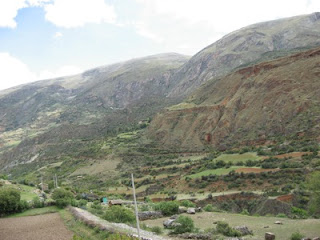If it was not for the journey, the destination would not be worth the bother. It is a small town, of no special interest. In fact, I spent a matter of 2 or 3 hours in the town, most of it around the bus station!
Getting to Huancavelica was relatively easy. Getting out however proved to be a major challenge. In particular, I wanted to travel to the town of Ayuchocho - a mountain town about 400 Km away. However, I could not find any busses that go there, and was told that the roads were too bad at this time of the year (it is the rainy season in the Andes) and no direct routes exist. Instead I was adviced to go to another town from where I could catch a connecting bus. While the direct bus would have been a matter of 8 hours at most, the new route would be at least 16 hours of traveling ... if I got a bus. While I did buy a ticket with that intention, I changed my mind and decided to just carry on with the bus to the coastal town of Pisco and change my route of travel instead.
I am sure my route would have been similar, and I would really love to do this route during the day. A few weeks ago, BBC's Top Gear presented a segment on the "Greatest Driving Road" in the world. If they were to consider unpaved roads, the road down along the mountain after Huancavelica to Pisco should win it comfortable.
Simply put, it is the most terrifying road I have ever been on ... and I loved every moment of it (of which I was awake ... I was asleep for large parts of the journey). Basically it was an unpaved road (a smooth dirt road if that makes sense) cut against the mountain. There were very few road signs, and no guard rails. On one side: the mountain. The other side: a drop into the valley. This off course meant that passing vehicles was an adventure in itself ... luckily only happened twice. There were two other hazards, both of which required all the passengers to get out: a rockfall and a narrow bridge. I must say: the driver was amazing and drove with great skill - although he was hardly hurtling the bus down the hill.
For the moments I was awake, it was an amazing journey: moonlit, clear skies lighting up basically a black valley of tree tops. The trip must be amazing during the day! Huancavelica is not worth much as a town - but the journey to and from the town is worth a day's travel.














































